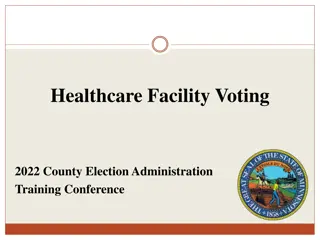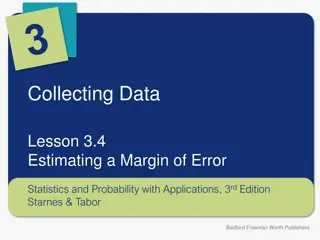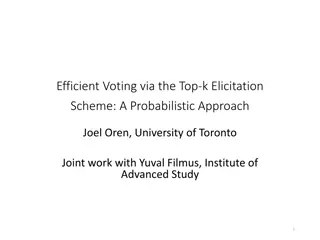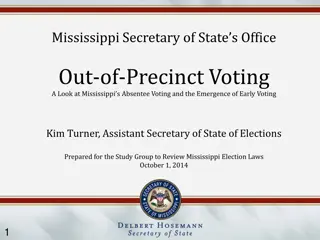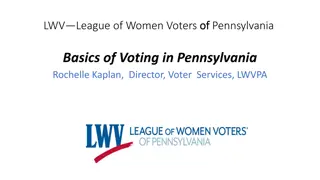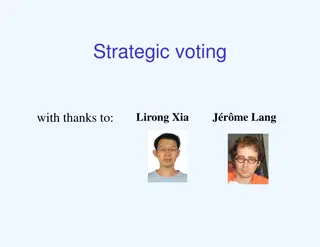Complexity of Computing Margin of Victory in Voting Rules
The research delves into the computational complexity of determining the margin of victory for various voting rules, which is crucial for post-election audits and understanding the closeness of election outcomes. It explores how the margin of victory is calculated, provides examples illustrating the concept, and discusses the related manipulation problems. The study highlights the significance of efficient auditability and the implications of margin of victory in determining political mandates.
Download Presentation

Please find below an Image/Link to download the presentation.
The content on the website is provided AS IS for your information and personal use only. It may not be sold, licensed, or shared on other websites without obtaining consent from the author. Download presentation by click this link. If you encounter any issues during the download, it is possible that the publisher has removed the file from their server.
E N D
Presentation Transcript
Complexity of Computing the Margin of Victory for Various Voting Rules Ronald L. Rivest Emily Shen Lirong Xia CAEC, Nov. 18, 2011
Voting > > voting rule > > > > 1
Criteria for voting rules Lots of voting rules (plurality, approval, instant runoff voting, etc.) How to choose one? Traditional criteria: monotonicity, consistency, majority, etc. More recently: computational complexity of manipulation (strategic voting) We consider: efficient auditability specifically, computational complexity of computing margin of victory (related to manipulation problems)
Margin of Victory (MoV) Definition: Given a profile of ballots, the margin of victory is the smallest number k such that k modified ballots could change the election winner Margin of victory is critical to efficient, effective post-election audits To provide a given level of statistical confidence, landslide election requires much less checking than a close election Margin of victory is a measure of closeness of election, suggests level of political mandate won by winner 3
Margin of Victory Examples Plurality A:10 votes, B: 15 votes, C: 4 votes Margin of victory = 3 Instant-runoff voting (IRV) A>B>C 10 B>A>C 15 C>A>B 4 Margin of victory = 1 4
The MoV computational problem Computational problem MoV: compute margin of victory of a profile of ballots Decision problem MoVk: Is the margin of victory at most k? MoV problem closely related to previously studied manipulation problems: UCM, bribery 5
Margin of Victory & Related Manipulation Problems Desired Complexity Problem Objective By Margin of Victory Change the winner Changing votes Low Unweighted Coalitional Manipulation Make a given candidate win Adding votes High Make a given candidate win Bribery Changing votes High 6
Our Results Margin of Victory This work Unweighted Coalitional Manipulation P (1 manipulator) Voting rule [BTT89] Positional scoring rules Including Borda [XCP10] [DKNW11] [BNW11] P NPC (2 or more) P P Plurality with runoff [ZPR09] P (1 manipulator) NPC (2 or more) [BTT89] NPC and FPT Copeland [FHS08,10] P (1 manipulator) [BTT89] NPC and FPT Maximin NPC (2 or more) [XZP+09] NPC for MoV1 NPC STV [BO91] NPC for MoV1 NPC Ranked pairs [XZP+09] ? NPC Nanson s rule [NWX11] ? NPC Baldwin s rule [NWX11] 7
Poly-time margin algorithm for plurality with runoff Let d be the current winner For every k Check whether there is a way to make d not in the runoff by changing k votes Check for every adversarial c, every threshold l, whether there is a way to change k votes such that c and d are ranked at the top for at least l times Any other alternative is ranked at the top for no more than l times c beats d in their pairwise election 8
IRV Margin of Victory = 1 is NP-Complete Proof by reduction from unweighted coalitional manipulation problem Tweak UCM1 profile P to get new profile P by: Adding a new candidate d Ranking d just below c in P Adding |P|+1 voters who all rank d as 1st choice Show: MoV of P is 1 if and only if UCM1 has a solution 9
Summary and Future Work We studied complexity of computing the margin of victory for some common voting rules Future work: Complexity of MoVk (k > 1) for IRV, ranked pairs Practical algorithms to compute/approximate margin of victory for IRV, ranked pairs Heuristics, approximation algorithms 10






